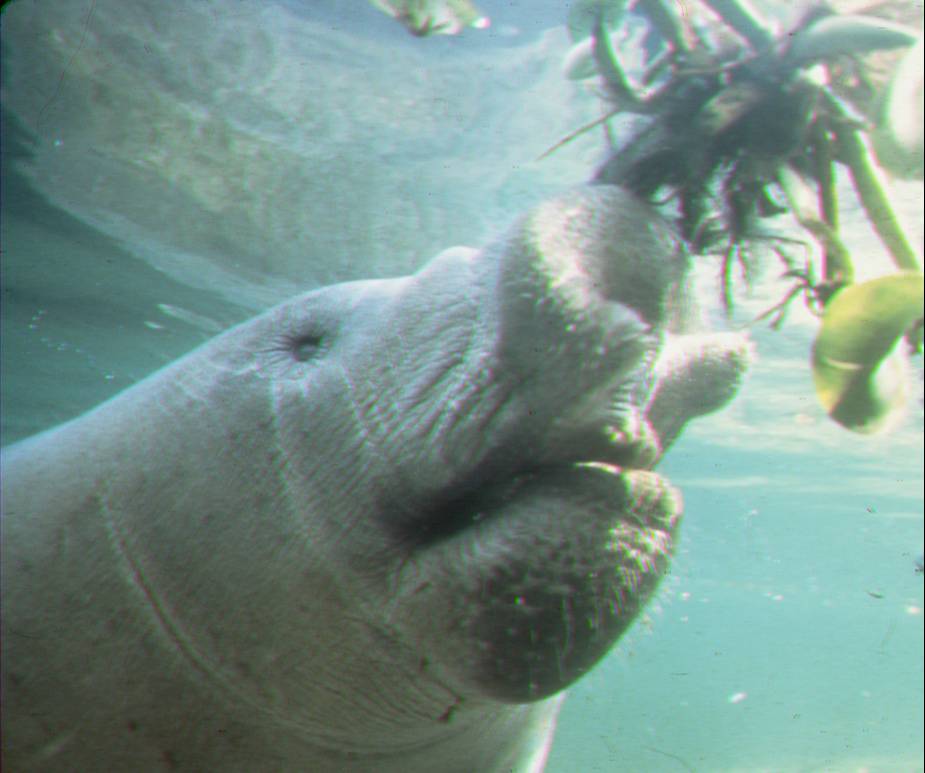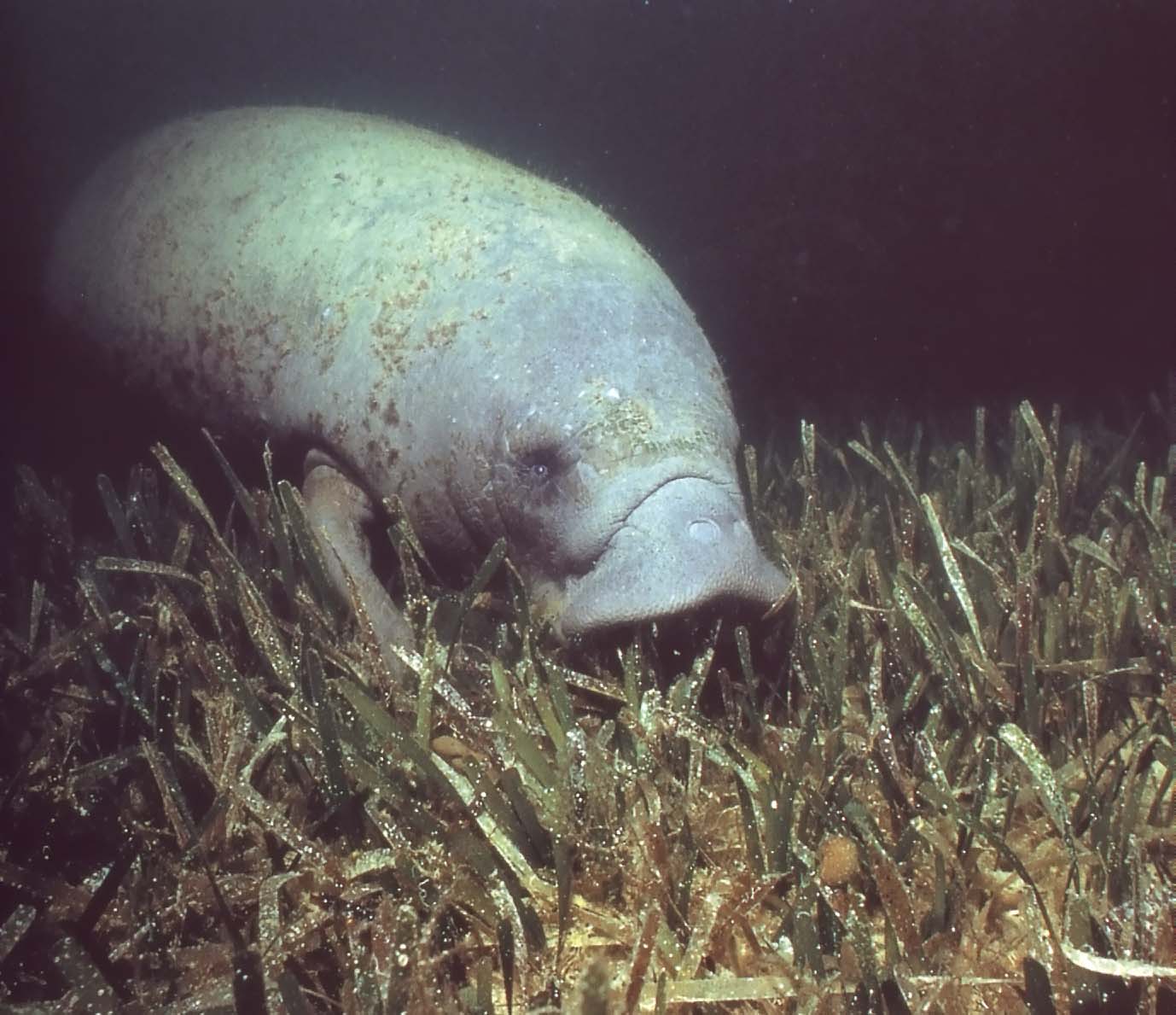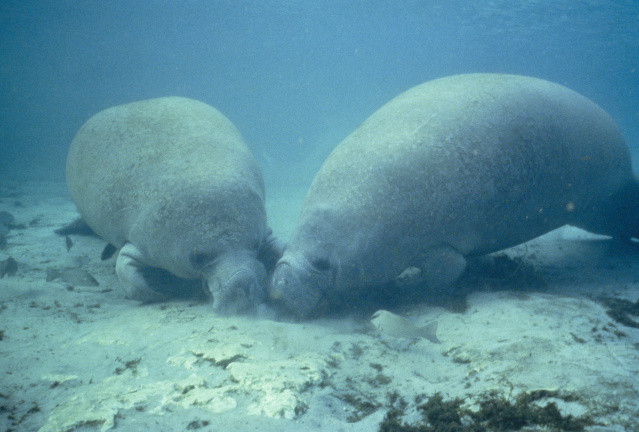Nutrition
Manatees are generally thought of to be strictly herbivores;
however this isn't true. It isn't uncommon for
 T.
manatus to eat a small vertebrate fish, but their diets are
80% comprised of sea grasses.
(Mignucii-Giannoni et al., 2006).
Because sea grass has very low amounts of nutrients the T.
manatus will often spend up to 8 hours a day
grazing, and consume up to 10% of its body weight in order to
keep up with its daily metabolic needs
(Mignucii-Giannoni et al., 2006). This lifestyle has given
rise to a few positive evolutionary adaptations. The mouth of
T. manatus has been modified by means of a split upper lip
as seen in the picture to the left. The split upper lip allows
the T. manatus to easily pass food to their mouth while
they swim without having to stop and readjust themselves(Mignucii-Giannoni
et al., 2006). Because all manatees feed on abrasive plants
their molars will wear down over time. Manatees, however, have the
ability to replace their molars as their previous ones wear
down; this makes it significantly easier to masticate their
T.
manatus to eat a small vertebrate fish, but their diets are
80% comprised of sea grasses.
(Mignucii-Giannoni et al., 2006).
Because sea grass has very low amounts of nutrients the T.
manatus will often spend up to 8 hours a day
grazing, and consume up to 10% of its body weight in order to
keep up with its daily metabolic needs
(Mignucii-Giannoni et al., 2006). This lifestyle has given
rise to a few positive evolutionary adaptations. The mouth of
T. manatus has been modified by means of a split upper lip
as seen in the picture to the left. The split upper lip allows
the T. manatus to easily pass food to their mouth while
they swim without having to stop and readjust themselves(Mignucii-Giannoni
et al., 2006). Because all manatees feed on abrasive plants
their molars will wear down over time. Manatees, however, have the
ability to replace their molars as their previous ones wear
down; this makes it significantly easier to masticate their food and in turn easier for enzymes to break it down(Mignucii-Giannoni
et al., 2006). T. manatus has a very slow
metabolic rate which plays a key role in why T. manatus
cannot survive in colder climates; instead this decreased
metabolic rate helps them
survive on their primary diet of sea grasses. The slow rate of T. manatus
allows them to survive on 25% less
energy than a typical mammal of a similar size
(Douglas, 1986). Their hind gut also undergoes fermentation
to assist in the process of breaking down cellulose from the
plants that are eaten(Douglas, 1986).
Lastly, the T. manatus has a snout that is
bent further down than other species of the family. This
attribute makes
it easier for T. manatus to graze the plants attached
to the sea floor. (Mignucii-Giannoni et
al., 2006).
food and in turn easier for enzymes to break it down(Mignucii-Giannoni
et al., 2006). T. manatus has a very slow
metabolic rate which plays a key role in why T. manatus
cannot survive in colder climates; instead this decreased
metabolic rate helps them
survive on their primary diet of sea grasses. The slow rate of T. manatus
allows them to survive on 25% less
energy than a typical mammal of a similar size
(Douglas, 1986). Their hind gut also undergoes fermentation
to assist in the process of breaking down cellulose from the
plants that are eaten(Douglas, 1986).
Lastly, the T. manatus has a snout that is
bent further down than other species of the family. This
attribute makes
it easier for T. manatus to graze the plants attached
to the sea floor. (Mignucii-Giannoni et
al., 2006).
Like many animals, the diet of T. manatus plays a key
role in where their habitat is. Follow this
link and check out where the
T.manatus calls home! Or click here to
return to the home page.
